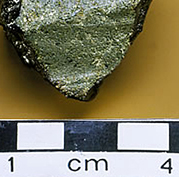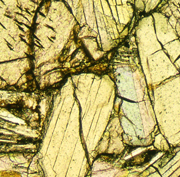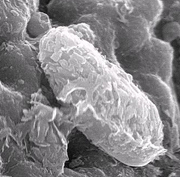Official Name:
Nakhla is the name most commonly used for this meteorite. It is the name of one of the hamlets where the meteorite fragments were found. The names Ebdel Malek and El Nakhla el Baharia are also used.
Location:
Near the village of Abu Hommos near Alexandria, Egypt.
Fall or Find:
Fall
Date:
28 June 1911, 9 a.m., local time.
Mass Recovered:
10 kilograms
Number of Fragments:
About 40 fragments have been recovered from this friable meteorite, which is just barely magnetic. Their masses vary from 20 to 1 813 grams.
Strewn field:
When the strewn field was first investigated, a distance of 4.5 kilometres separated the two meteorites that landed the farthest apart from one another. It is possible that the strewn field was much larger.
Crater:
The largest fragments sank about one metre into the sandy ground, creating small depressions.
Circumstances:
First there were loud explosions, then trails of smoke appeared in the sky, and, finally, rocks came raining down on the ground. Several villagers collected these rocks that fell from the sky.

Enlargement
During the Nakhla meteorite fall, some say a dog was in the wrong place at the wrong time. |
|
History:
A farmer in the area claimed a dog was struck and killed-vaporized-by this meteorite. The authenticity of this story has never been proven and always stirs people's passions. Legend or reality? We will probably never know, given how long ago this event occurred.

Enlargement
A fragment of the Nakhla meteorite with its shiny fusion crust clearly visible. The interior of the fragment is flecked with green particles. |
|

Enlargement
Greenish diopside crystals in the achondrite Nakhla. |
|
Type:
Stony meteorite
Class:
Achondrite
Group:
SNC (for "shergottite," "nakhlite," and "chassignite"). This is one of the meteorites for which the group was named. It is, to be more precise, a nakhlite.
Composition:
Nakhla is mainly composed of green diopside (a mineral in the pyroxene group), iron-rich olivine, and a bit of feldspar. Clusters of pyroxene crystals indicate that the stone formed during magma cooling. Total iron content accounts for 16.2% of the meteorite's volume.
Scientific contribution:
It took 70 years after the Nakhla fall for its Martian origin to be recognized. Two main clues led to this conclusion. Its "young" age of 1.3 billion years indicated that the meteorite came from a celestial body large enough to have maintained geological activity during a good part of the solar system's history. Comparison of gases trapped in the meteorite with gases recorded in the Mars atmosphere by the Viking probe then confirmed the meteorite's Martian origin. Today, there is no doubt about the origin of Nakhla. Scientists have even determined that it probably came from the Tharsis Bulge in the northern hemisphere of the red planet.
Recently, Nakhla reopened the debate over life on Mars. Through a microscope, orange clay-rich veinlets can be seen inside the meteorite. They prove that the meteorite was altered by liquid water. Some scientists say that Nakhla contains the fossilized remains of bacterial cells in the form of microscopic round units.

Enlargement
Bacterial fossil found in the Nakhla meteorite. |
|
Comments:
Nakhla is the first authenticated fall in Egypt.
Part of the Planétarium's collection:
No